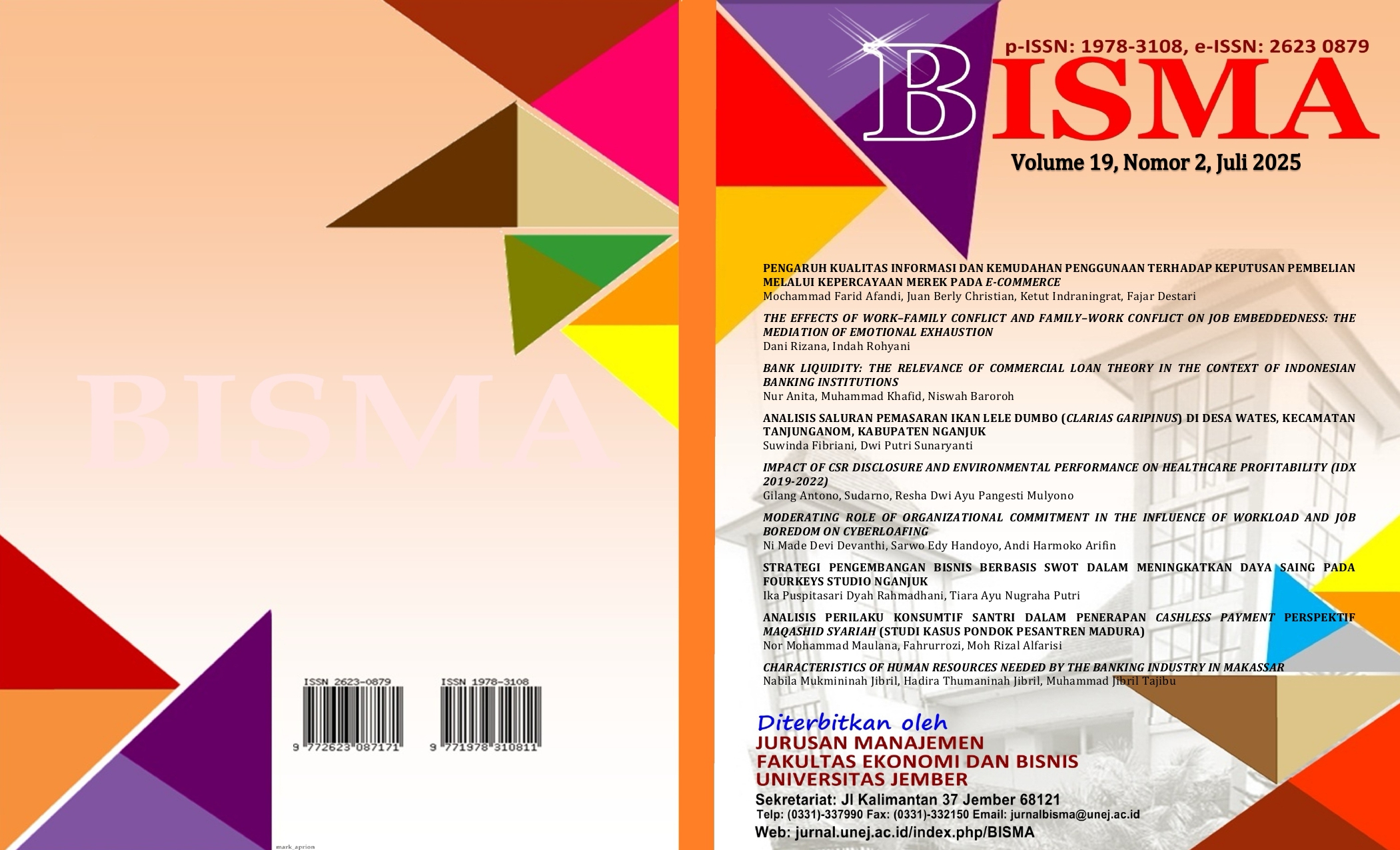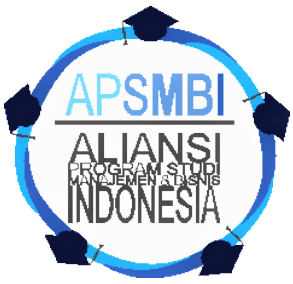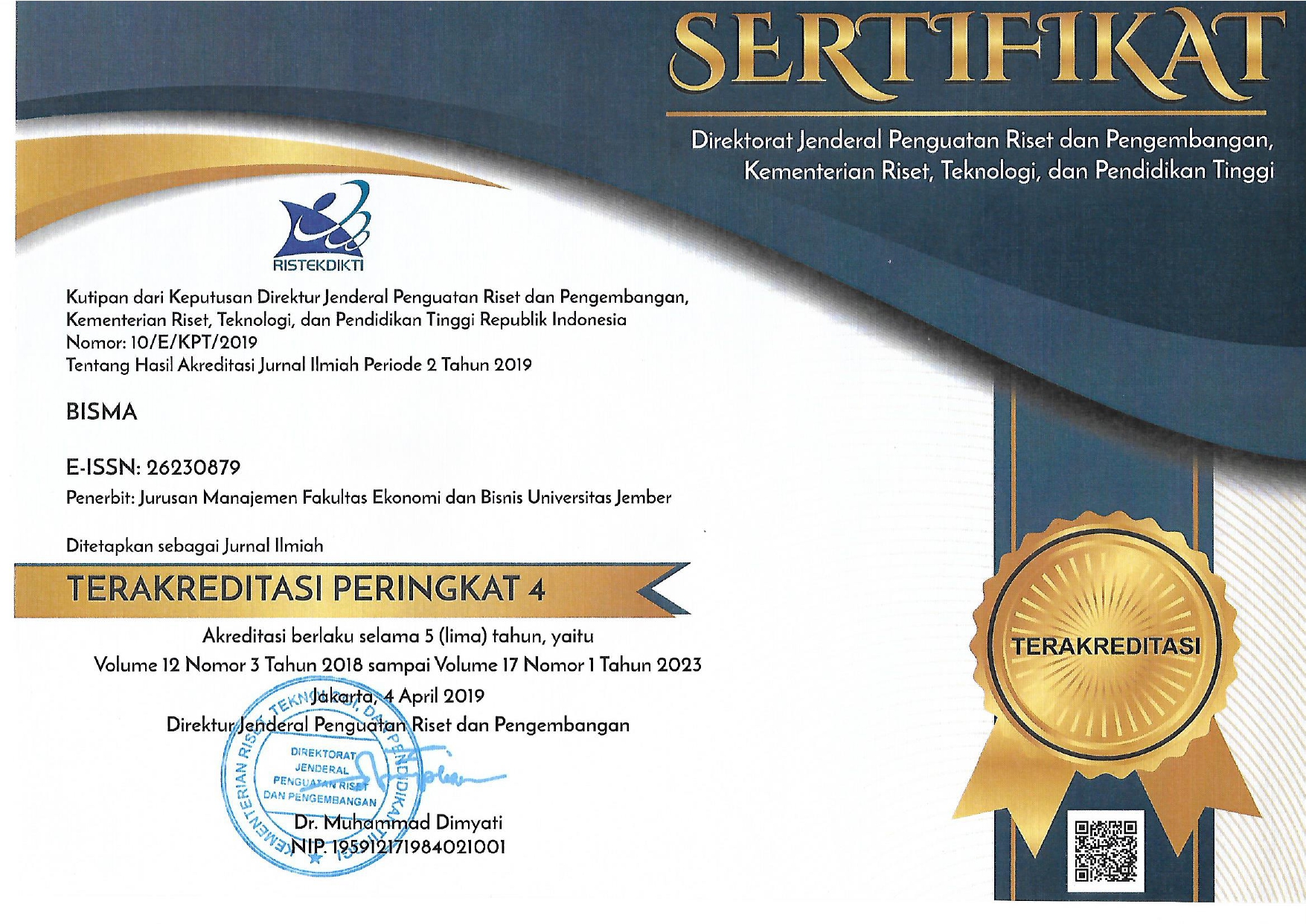THE EFFECTS OF WORK–FAMILY CONFLICT AND FAMILY–WORK CONFLICT ON JOB EMBEDDEDNESS : THE MEDIATION OF EMOTIONAL EXHAUSTION
DOI:
https://doi.org/10.19184/bisma.v19i2.53773Keywords:
Work–Family Conflict, Family–Work Conflict, emotional exhaustion, job embeddednessAbstract
This study investigates the influence of Work–Family Conflict (WFC) and Family–Work Conflict (FWC) on Job Embeddedness, with Emotional Exhaustion serving as a mediating variable. A quantitative research approach was employed, using Structural Equation Modeling (SEM) with the Partial Least Squares (PLS) method. Data were collected through a survey of 300 courier expedition employees in Indonesia using a convenience sampling technique. The findings reveal that both WFC and FWC negatively and significantly affect Job Embeddedness, while simultaneously exerting a positive and significant impact on Emotional Exhaustion. Emotional Exhaustion, in turn, has a negative and significant effect on Job Embeddedness. The mediation analysis further confirms that Emotional Exhaustion significantly mediates the relationship between role conflicts and Job Embeddedness. These results highlight the detrimental effect of work-family conflicts on employees’ emotional well-being and their organizational attachment. The study underscores the importance of organizational strategies that promote work-life balance to sustain employee engagement and reduce turnover.
Downloads
References
Arinasari, R., & Hartono, A. (2020). Work Overload Dan Family Work Conflict Terhadap Job Embeddedness Dengan Quality of Work Life Sebagai Variabel Intervening. JBTI : Jurnal Bisnis Teori Dan Implementasi, 11(2). https://doi.org/10.18196/bti.112134
Baumeister, R. F. (2002). Ego Depletion and Self-Control Failure: An Energy Model of the Self’s Executive Function. Self and Identity, 1(2), 129–136. https://doi.org/10.1080/152988602317319302
Baumeister, R. F., Vohs, K. D., & Tice, D. M. (2007). The strength model of self-control. Current Directions in Psychological Science, 16(6), 351–355. https://doi.org/10.1111/j.1467-8721.2007.00534.x
Crossley, C. D., Bennett, R. J., Jex, S. M., & Burnfield, J. L. (2007). Development of a Global Measure of Job Embeddedness and Integration Into a Traditional Model of Voluntary Turnover. Journal of Applied Psychology, 92(4), 1031–1042. https://doi.org/10.1037/0021-9010.92.4.1031
Dawley, D. D., & Andrews, M. C. (2012). Staying put: Off-the-job embeddedness as a moderator of the relationship between on-the-job embeddedness and turnover intentions. Journal of Leadership and Organizational Studies, 19(4), 477–485. https://doi.org/10.1177/1548051812448822
Dukhaykh, S. (2023). Exploring the Relationship Between Work–Family Conflict, Family–Work Conflict and Job Embeddedness: Examining the Mediating Role of Emotional Exhaustion. Psychology Research and Behavior Management, 16(November), 4859–4868. https://doi.org/10.2147/PRBM.S429283
Faisal, M. (2016). Pengaruh Work Overload, Work-Family Conflict Dan Family- Work Conflict Terhadap Job Embeddedness Karyawati Perbankan Nasional Banda Aceh Dengan Emotional Exhaustion Sebagai Variabel Mediasi. Skripsi, Universitas Syiah Kuala Darussalam, Banda Aceh.
Ford, M. T., Heinen, B. A., & Langkamer, K. L. (2007). Work and family satisfaction and conflict: A meta-analysis of cross-domain relations. Journal of Applied Psychology, 92(1), 57–80. https://doi.org/10.1037/0021-9010.92.1.57
Girsang, P. J., Absah, Y., & Purnomo, R. (2024). The Effect of Work Overload on Job Embeddedness with Quality of Work Life as an Intervening Variable at PT. Bank Mandiri (Persero) Tbk, Medan Imam Bonjol. Atlantis Press International BV. https://doi.org/10.2991/978-94-6463-234-7_137
Halbesleben, J. R. B., & Wheeler, A. R. (2008). The relative roles of engagement and embeddedness in predicting job performance and intention to leave. Work and Stress, 22(3), 242–256. https://doi.org/10.1080/02678370802383962
Kanten, P., Kanten, S., & Gurlek, M. (2015). The Effects of Organizational Structures and Learning Organization on Job Embeddedness and Individual Adaptive Performance. Procedia Economics and Finance, 23(October 2014), 1358–1366. https://doi.org/10.1016/s2212-5671(15)00523-7
Karatepe, O. M. (2013). The effects of work overload and work-family conflict on job embeddedness and job performance: The mediation of emotional exhaustion. International Journal of Contemporary Hospitality Management, 25(4), 614–634. https://doi.org/10.1108/09596111311322952
Kinnunen, U., Vermulst, A., Gerris, J., & Mäkikangas, A. (2003). Work-family conflict and its relations to well-being: The role of personality as a moderating factor. Personality and Individual Differences, 35(7), 1669–1683. https://doi.org/10.1016/S0191-8869(02)00389-6
Lee, T. W., Mitchell, T. R., Sablynski, C. J., Burton, J. P., & Holtom, B. C. (2004). The effects of job embeddedness on organizational citizenship, job performance, volitional absences, and voluntary turnover. Academy of Management Journal, 47(5), 711–722. https://doi.org/10.2307/20159613
Maslach, C., & Jackson, S. E. (1981). The measurement of experienced burnout. Journal of Organizational Behavior, 2(2), 99–113. https://doi.org/10.1002/job.4030020205
Michael Crotty. (2020). The foundations of social research: Meaning and perspective in the research process (1st ed.). Routledge. https://doi.org/https://doi.org/10.4324/9781003115700
Nasution. (2003). Metode Penelitian Naturalistik Kualitatif. Tarsito.
Netemeyer, R. G., Boles, J. S., & McMurrian, R. (1996). Development and validation of work-family conflict and family-work conflict scales. Journal of Applied Psychology, 81(4), 400–410. https://doi.org/10.1037/0021-9010.81.4.400
Putriwulandari, F. D., Sudjadi, A., & Indrayanto, A. (2018). The Effects of Work-Leisure Conflict, Work Overload and Work-Family Conflict on Job Embeddedness: Moderating Role of Perceived Supervisor Support. Journal of Research in Management, 1(3), 10–16. https://doi.org/10.32424/jorim.v1i3.45
Reitz, O. E., & Anderson, M. A. (2011). An Overview of Job Embeddedness. Journal of Professional Nursing, 27(5), 320–327. https://doi.org/10.1016/j.profnurs.2011.04.004
Santoso, S. (2014). Konsep Dasar dan Aplikasi SEM dengan AMOS 22. PT Gramedia Komputindo : Jakarta.
Schaufeli, W. B., & Bakker, A. B. (2004). Job demands, job resources, and their relationship with burnout and engagement: A multi-sample study. Journal of Organizational Behavior, 25(3), 293–315. https://doi.org/10.1002/job.248
Schaufeli, W. B., Bakker, A. B., & Salanova, M. (2006). The measurement of work engagement with a short questionnaire: A cross-national study. Educational and Psychological Measurement, 66(4), 701–716. https://doi.org/10.1177/0013164405282471
Sekaran, U. (2006). Metode Penelitiaan Bisnis. Salemba Empat.
Sonnentag, S., Kuttler, I., & Fritz, C. (2010). Job stressors, emotional exhaustion, and need for recovery: A multi-source study on the benefits of psychological detachment. Journal of Vocational Behavior, 76(3), 355–365. https://doi.org/10.1016/j.jvb.2009.06.005
van Daalen, G., Willemsen, T. M., Sanders, K., & van Veldhoven, M. J. P. M. (2009). Emotional exhaustion and mental health problems among employees doing “people work”: The impact of job demands, job resources and family-to-work conflict. International Archives of Occupational and Environmental Health, 82(3), 291–303. https://doi.org/10.1007/s00420-008-0334-0
Wang, I. A., Tsai, H. Y., Lee, M. H., & Ko, R. C. (2021). The effect of work–family conflict on emotional exhaustion and job performance among service workers: the cross-level moderating effects of organizational reward and caring. International Journal of Human Resource Management, 32(14), 3112–3133. https://doi.org/10.1080/09585192.2019.1651373
Xanthopoulou, D., Bakker, A. B., Demerouti, E., & Schaufeli, W. B. (2009). Reciprocal relationships between job resources, personal resources, and work engagement. Journal of Vocational Behavior, 74(3), 235–244. https://doi.org/10.1016/j.jvb.2008.11.003
Zhang, M., Fried, D. D., & Griffeth, R. W. (2012). A review of job embeddedness: Conceptual, measurement issues, and directions for future research. Human Resource Management Review, 22(3), 220–231. https://doi.org/10.1016/j.hrmr.2012.02.004
Downloads
Published
Issue
Section
License
Copyright (c) 2025 Dani Rizana, Indah Rohyani

This work is licensed under a Creative Commons Attribution-ShareAlike 4.0 International License.












.png)
 Bisma: Jurnal Bisnis dan Manajemen is licensed under a
Bisma: Jurnal Bisnis dan Manajemen is licensed under a 